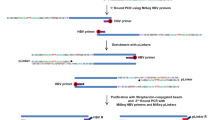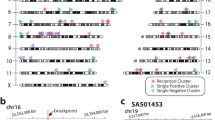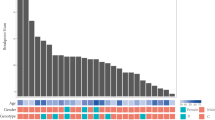Abstract
Hepatocellular carcinomas (HCCs) are liver tumors related to various etiologies, including alcohol intake and infection with hepatitis B (HBV) or C (HCV) virus. Additional risk factors remain to be identified, particularly in patients who develop HCC without cirrhosis. We found clonal integration of adeno-associated virus type 2 (AAV2) in 11 of 193 HCCs. These AAV2 integrations occurred in known cancer driver genes, namely CCNA2 (cyclin A2; four cases), TERT (telomerase reverse transcriptase; one case), CCNE1 (cyclin E1; three cases), TNFSF10 (tumor necrosis factor superfamily member 10; two cases) and KMT2B (lysine-specific methyltransferase 2B; one case), leading to overexpression of the target genes. Tumors with viral integration mainly developed in non-cirrhotic liver (9 of 11 cases) and without known risk factors (6 of 11 cases), suggesting a pathogenic role for AAV2 in these patients. In conclusion, AAV2 is a DNA virus associated with oncogenic insertional mutagenesis in human HCC.
This is a preview of subscription content, access via your institution
Access options
Subscribe to this journal
Receive 12 print issues and online access
$209.00 per year
only $17.42 per issue
Buy this article
- Purchase on Springer Link
- Instant access to full article PDF
Prices may be subject to local taxes which are calculated during checkout





Similar content being viewed by others
Accession codes
Primary accessions
NCBI Reference Sequence
Referenced accessions
NCBI Reference Sequence
References
Forner, A., Llovet, J.M. & Bruix, J. Hepatocellular carcinoma. Lancet 379, 1245–1255 (2012).
Fujimoto, A. et al. Whole-genome sequencing of liver cancers identifies etiological influences on mutation patterns and recurrent mutations in chromatin regulators. Nat. Genet. 44, 760–764 (2012).
Guichard, C. et al. Integrated analysis of somatic mutations and focal copy-number changes identifies key genes and pathways in hepatocellular carcinoma. Nat. Genet. 44, 694–698 (2012).
Nault, J.C. et al. High frequency of telomerase reverse-transcriptase promoter somatic mutations in hepatocellular carcinoma and preneoplastic lesions. Nat. Commun. 4, 2218 (2013).
Totoki, Y. et al. Trans-ancestry mutational landscape of hepatocellular carcinoma genomes. Nat. Genet. 46, 1267–1273 (2014).
Schulze, K. et al. Exome sequencing of hepatocellular carcinomas identifies new mutational signatures and potential therapeutic targets. Nat. Genet. 47, 505–511 (2015).
Sung, W.K. et al. Genome-wide survey of recurrent HBV integration in hepatocellular carcinoma. Nat. Genet. 44, 765–769 (2012).
Paterlini-Bréchot, P. et al. Hepatitis B virus–related insertional mutagenesis occurs frequently in human liver cancers and recurrently targets human telomerase gene. Oncogene 22, 3911–3916 (2003).
Nault, J.C. et al. Telomerase reverse transcriptase promoter mutation is an early somatic genetic alteration in the transformation of premalignant nodules in hepatocellular carcinoma on cirrhosis. Hepatology 60, 1983–1992 (2014).
Pilati, C. et al. Genomic profiling of hepatocellular adenomas reveals recurrent FRK-activating mutations and the mechanisms of malignant transformation. Cancer Cell 25, 428–441 (2014).
Atchison, R.W., Casto, B.C. & Hammon, W.M. Adenovirus-associated defective virus particles. Science 149, 754–756 (1965).
Smith, R.H. Adeno-associated virus integration: virus versus vector. Gene Ther. 15, 817–822 (2008).
Flotte, T.R. & Berns, K.I. Adeno-associated virus: a ubiquitous commensal of mammals. Hum. Gene Ther. 16, 401–407 (2005).
Samulski, R.J. et al. Targeted integration of adeno-associated virus (AAV) into human chromosome 19. EMBO J. 10, 3941–3950 (1991).
McAlister, V.J. & Owens, R.A. Preferential integration of adeno-associated virus type 2 into a polypyrimidine/polypurine-rich region within AAVS1. J. Virol. 81, 9718–9726 (2007).
Kotin, R.M. et al. Site-specific integration by adeno-associated virus. Proc. Natl. Acad. Sci. USA 87, 2211–2215 (1990).
Deshpande, A., Sicinski, P. & Hinds, P.W. Cyclins and CDKs in development and cancer: a perspective. Oncogene 24, 2909–2915 (2005).
Berasain, C. et al. Oncogenic activation of a human cyclin A2 targeted to the endoplasmic reticulum upon hepatitis B virus genome insertion. Oncogene 16, 1277–1288 (1998).
Johnstone, R.W., Frew, A.J. & Smyth, M.J. The TRAIL apoptotic pathway in cancer onset, progression and therapy. Nat. Rev. Cancer 8, 782–798 (2008).
Ding, D. et al. Recurrent targeted genes of hepatitis B virus in the liver cancer genomes identified by a next-generation sequencing–based approach. PLoS Genet. 8, e1003065 (2012).
Gonçalves, M.A. Adeno-associated virus: from defective virus to effective vector. Virol. J. 2, 43 (2005).
Neuveut, C., Wei, Y. & Buendia, M.A. Mechanisms of HBV-related hepatocarcinogenesis. J. Hepatol. 52, 594–604 (2010).
Martin, D. & Gutkind, J.S. Human tumor-associated viruses and new insights into the molecular mechanisms of cancer. Oncogene 27 (suppl. 2), S31–S42 (2008).
Wang, J., Chenivesse, X., Henglein, B. & Brechot, C. Hepatitis B virus integration in a cyclin A gene in a hepatocellular carcinoma. Nature 343, 555–557 (1990).
Haberman, R.P., McCown, T.J. & Samulski, R.J. Novel transcriptional regulatory signals in the adeno-associated virus terminal repeat A/D junction element. J. Virol. 74, 8732–8739 (2000).
Baudard, M. et al. Expression of the human multidrug resistance and glucocerebrosidase cDNAs from adeno-associated vectors: efficient promoter activity of AAV sequences and in vivo delivery via liposomes. Hum. Gene Ther. 7, 1309–1322 (1996).
Moore, P.S. & Chang, Y. Why do viruses cause cancer? Highlights of the first century of human tumour virology. Nat. Rev. Cancer 10, 878–889 (2010).
Calcedo, R., Vandenberghe, L.H., Gao, G., Lin, J. & Wilson, J.M. Worldwide epidemiology of neutralizing antibodies to adeno-associated viruses. J. Infect. Dis. 199, 381–390 (2009).
Halbert, C.L. et al. Prevalence of neutralizing antibodies against adeno-associated virus (AAV) types 2, 5, and 6 in cystic fibrosis and normal populations: implications for gene therapy using AAV vectors. Hum. Gene Ther. 17, 440–447 (2006).
Nathwani, A.C. et al. Adenovirus-associated virus vector-mediated gene transfer in hemophilia B. N. Engl. J. Med. 365, 2357–2365 (2011).
LeWitt, P.A. et al. AAV2-GAD gene therapy for advanced Parkinson's disease: a double-blind, sham-surgery controlled, randomised trial. Lancet Neurol. 10, 309–319 (2011).
Donsante, A. et al. AAV vector integration sites in mouse hepatocellular carcinoma. Science 317, 477 (2007).
Chandler, R.J. et al. Vector design influences hepatic genotoxicity after adeno-associated virus gene therapy. J. Clin. Invest. 125, 870–880 (2015).
Wang, P.R. et al. Induction of hepatocellular carcinoma by in vivo gene targeting. Proc. Natl. Acad. Sci. USA 109, 11264–11269 (2012).
Bell, P. et al. Analysis of tumors arising in male B6C3F1 mice with and without AAV vector delivery to liver. Mol. Ther. 14, 34–44 (2006).
Rosas, L.E. et al. Patterns of scAAV vector insertion associated with oncogenic events in a mouse model for genotoxicity. Mol. Ther. 20, 2098–2110 (2012).
Gnirke, A. et al. Solution hybrid selection with ultra-long oligonucleotides for massively parallel targeted sequencing. Nat. Biotechnol. 27, 182–189 (2009).
Rebouissou, S. et al. Frequent in-frame somatic deletions activate gp130 in inflammatory hepatocellular tumours. Nature 457, 200–204 (2009).
Li, H. & Durbin, R. Fast and accurate long-read alignment with Burrows-Wheeler transform. Bioinformatics 26, 589–595 (2010).
Li, H. et al. The Sequence Alignment/Map format and SAMtools. Bioinformatics 25, 2078–2079 (2009).
Thorvaldsdóttir, H., Robinson, J.T. & Mesirov, J.P. Integrative Genomics Viewer (IGV): high-performance genomics data visualization and exploration. Brief. Bioinform. 14, 178–192 (2013).
Rebouissou, S. et al. Germline hepatocyte nuclear factor 1α and 1β mutations in renal cell carcinomas. Hum. Mol. Genet. 14, 603–614 (2005).
Trapnell, C. et al. Differential gene and transcript expression analysis of RNA-seq experiments with TopHat and Cufflinks. Nat. Protoc. 7, 562–578 (2012).
Trapnell, C., Pachter, L. & Salzberg, S.L. TopHat: discovering splice junctions with RNA-Seq. Bioinformatics 25, 1105–1111 (2009).
Katz, Y., Wang, E.T., Airoldi, E.M. & Burge, C.B. Analysis and design of RNA sequencing experiments for identifying isoform regulation. Nat. Methods 7, 1009–1015 (2010).
Corpet, F. Multiple sequence alignment with hierarchical clustering. Nucleic Acids Res. 16, 10881–10890 (1988).
Tamura, K. & Nei, M. Estimation of the number of nucleotide substitutions in the control region of mitochondrial DNA in humans and chimpanzees. Mol. Biol. Evol. 10, 512–526 (1993).
Tamura, K., Stecher, G., Peterson, D., Filipski, A. & Kumar, S. MEGA6: Molecular Evolutionary Genetics Analysis version 6.0. Mol. Biol. Evol. 30, 2725–2729 (2013).
Hope, A.C. A simplified Monte Carolo significance test procedure. J. R. Stat. Soc., B 30, 582–598 (1968).
Acknowledgements
We warmly thank L. Yost, E. Chevet and A. de Reynies for critical review of the manuscript and helpful discussion. We thank all the clinician surgeons and pathologists who have participated in this work: J. Saric, C. Laurent, L. Chiche, B. Le Bail and C. Castain (CHU Bordeaux) and Y. Allory, K. Leroy and D. Azoulay (CHU Henri Mondor). We also thank the Réseau National Centre de Ressources Biologiques (CRB) Foie and the tumor banks of CHU Bordeaux and CHU Henri Mondor for contributing to the tissue collection. This work was supported by Institut Nationale du Cancer (INCa) with the International Cancer Genome Consortium (ICGC) and the PAIR-CHC project NoFLIC (also funded by Association pour la Recherche sur le Cancer (ARC)). The group is supported by the Ligue Nationale contre le Cancer. J.-C.N., M.M., C.P. and A.F. were supported by fellowships from INCa, AERIO-Boehringer-Ingelheim, ARC and the Ligue Nationale contre le Cancer, respectively.
Author information
Authors and Affiliations
Contributions
J.-C.N., S.D., S.I. and J.Z.-R. designed the study and wrote the manuscript. J.Z.-R. conceived and directed the research. J.-C.N., S.D., A.F., M.M., G.C., C.P. and B.V. performed the experiments. J.-C.N., S.D., S.I., A.F., M.M., G.C., E.L., C.P., B.V., F.C. and J.Z.-R. analyzed and interpreted the data. S.I., E.L. and M.L. performed bioinformatics and statistical analysis. J.-F.B., C.B., J.C., A.L. and P.B.-S. provided essential biological resources and collected clinical data. All authors approved the final manuscript and contributed to critical revisions to its intellectual context.
Corresponding author
Ethics declarations
Competing interests
IntegraGen performed all the next-generation sequencing, and M.L. is an employee of IntegraGen. All other authors declare no competing financial interests.
Supplementary information
Supplementary Text and Figures
Supplementary Figures 1–9 and Supplementary Tables 1 and 2. (PDF 1597 kb)
Rights and permissions
About this article
Cite this article
Nault, JC., Datta, S., Imbeaud, S. et al. Recurrent AAV2-related insertional mutagenesis in human hepatocellular carcinomas. Nat Genet 47, 1187–1193 (2015). https://doi.org/10.1038/ng.3389
Received:
Accepted:
Published:
Issue Date:
DOI: https://doi.org/10.1038/ng.3389
This article is cited by
-
tRNA therapeutics for genetic diseases
Nature Reviews Drug Discovery (2024)
-
A dual role for adeno-associated virus in human health
Virology Journal (2023)
-
Cell and gene therapy for kidney disease
Nature Reviews Nephrology (2023)
-
Empowering gene delivery with protein engineering platforms
Gene Therapy (2023)
-
Changing trends in the development of AAV-based gene therapies: a meta-analysis of past and present therapies
Gene Therapy (2023)



